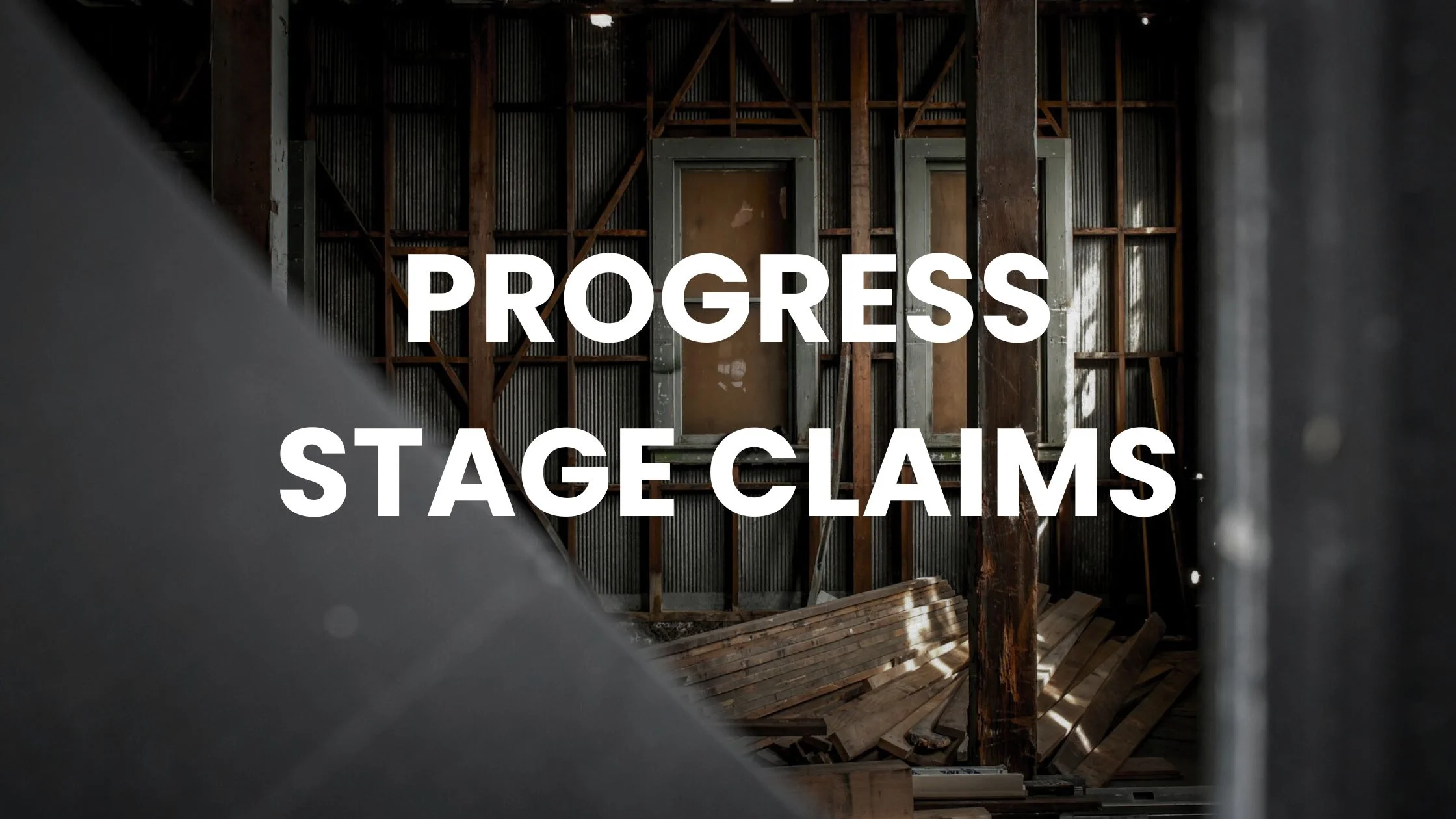Progress Stage Claims in New Home Construction: A Comprehensive Guide

Discover the secrets to hassle-free
home planning and craft your
dream home with confidence,
one step at a time.
Understanding Progress Stage Claims and Their Importance in Construction Contracts
As a carpenter and new home estimator, turned founder at Foresight Home Planning, I’ve seen firsthand the crucial role progress stage claims play in the construction of new homes.
Progress stage claims, also known as progress payments, are periodic payments made by the homeowner to the builder based on the completion of specific stages of work, as outlined in the building contract. These claims ensure a steady cash flow for the builder while providing the homeowner with a way to track the progress of their new home construction and manage the associated risks.
Prior to signing a contract with a builder or contractor, homeowners need to review the proposed dollar figures associated with each stage of the project and ensure that each claim amount is proportionate to the value of the work completed. This helps protect the homeowner in case the builder is unable or unwilling to complete the job, ensuring sufficient funds remain available to finish the project with another builder should this unfortunate circumstance arise.
Please note that this article is specifically tailored to the Queensland market, other Australian states may have different requirements however, interstate readers will still benefit from understanding the content in this article.
Progress Stage Claim Regulations in Queensland
In Queensland, the Queensland Building and Construction Commission Act 1991 (QBCC Act) regulates progress stage claims and deposit limits for new home construction. According to the QBCC, the maximum deposit allowed before work starts on site is:
- 10% where the total contract price is less than $20,000
- 5% where the price is $20,000 or more
- 20% for a contract of any price where the value of the work to be performed off-site is more than 50% of the contract price
In the scenario where a builder is constructing a home on the client’s block of land, the deposit should not exceed 5% of the contracted value, as the total contract price is likely to be $20,000 or more. This 5% deposit limit ensures that homeowners are protected from paying excessive upfront costs and helps maintain a fair balance between the interests of the builder and the client.
After the deposit is paid, homeowners and builders are free to choose the number and timing of progress payments, provided the amount claimed directly relates to work progress on-site and is proportionate to, or less than, the value of the work that relates to the claim.
While the QBCC Act stipulates how builders should operate and create their contracts, it doesn’t necessarily prevent them from breaching the Act. It’s the homeowner’s responsibility to ensure the builder’s contract complies with the rules and regulations before signing.
Once signed, the builder may assert that their contract is in accordance with the QBCC Act, even if it isn’t, and will likely enforce the contract. Therefore, it’s prudent to exercise caution when entering contracts. Review all details and cross-check its legality against the QBCC Act. Failing to do so could lead to disputes with the builder, resulting in time-consuming legal cases and project delays
Understanding the Different Stages of Construction
Progress stage claims are typically tied to the completion of specific stages of construction. While the exact stages and their definitions may vary slightly between builders and contracts, the following are common stages found in most residential construction projects:
1. Deposit Stage: This is the initial payment made to the builder before work commences on-site. As mentioned earlier, the deposit amount is regulated by the QBCC Act.
2. Base Stage: Also known as the slab stage, this is when the foundation of the home is laid, including excavation, footings, under-slab drainage, and the concrete slab.
3. Frame Stage: During this stage, the home’s structural framework is erected, including wall frames, roof trusses, and door frames.
4. Lockup or Enclosed Stage: At this point, the home is considered “locked up,” with the installation of external walls, doors, and windows. The roof is also completed during this stage.
5. Fixout or Fixing Stage: This is when the interior of the home begins to take shape. Electrical and plumbing rough-ins are completed, and internal linings, plasterboard, doors, and shelving are installed.
6. Practical Completion Stage: In this final stage, the home is considered complete and ready for handover. This includes the installation of fixtures and fittings, painting, and final touches.
7. Final Completion Stage: This stage occurs after the homeowner has had the opportunity to inspect the property and identify any remaining defects or incomplete work. Once these items have been addressed, the final payment is made, and the construction process is considered complete.
It’s essential for homeowners to familiarize themselves with these stages and the specific work that falls under each stage in their building contract. This knowledge will help them understand when progress stage claims are due and ensure that they are not making payments for incomplete work.
The Process of Progress Stage Claims in New Home Construction
Progress stage claims are an integral part of the new home construction process, ensuring that builders receive payment for their work and that homeowners have set guidelines in place that ensures payments are made at the appropriate time.
The following steps outline the typical process a builder will take when they submit a progress stage claim to the home owner:
1. Completion of Work Stage: As per the building contract, the builder completes a defined stage of work, such as the slab, frame, or lockup stage.
2. Submission of Progress Claim: Once a stage is completed, the builder prepares and submits a detailed progress claim to the homeowner. This claim includes a description of the work completed and the corresponding amount due.
3. Inspection and Verification: Upon receiving the progress claim, the homeowner or their appointed representative, such as a building inspector or quantity surveyor, inspects the completed work to ensure it meets the requirements outlined in the building contract and the relevant building codes and standards.
4. Payment Approval and Release: If the work is deemed satisfactory and in compliance with the contract, the building inspector and homeowner approve the progress claim and releases the payment to the builder, allowing them to proceed to the next stage of construction.
By adhering to this process, both builders and homeowners can maintain a transparent and efficient construction process, minimizing the risk of disputes and ensuring that the project stays on track and within budget.
The Difference Between an Invoice and a Progress Stage Claim
When it comes to new home construction, it’s essential to understand the distinction between an invoice and a progress claim, as these terms are often used interchangeably but have different meanings and purposes.
A progress claim is a detailed document submitted by the builder to the homeowner, outlining the work completed during a specific stage of construction and the corresponding amount due. This document may include images of the completed stage claim work making it easy for the home owner to identify that the required work has been completed.
This claim is based on the agreed-upon progress stage claim schedule in the building contract. The homeowner or their representative then assesses the claim, verifying that the work has been completed satisfactorily before approving payment.
An invoice, on the other hand, is a formal request for payment issued by the builder after the progress claim has been approved. The invoice includes the total amount due for the completed work and specifies the payment terms, such as the due date and payment method.
In some cases, builders may be required to provide additional documentation, such as statutory declarations, to support their progress claims and invoices. These declarations serve as legal confirmation that the work has been completed as described and that the builder has met their obligations under the building contract.
Variations and Their Impact on Progress Stage Claims
In Queensland, all variations to a construction contract must be agreed upon in writing by the homeowner before the variation work commences, and any price increase due to the variation cannot be required to be paid until the variation work is completed.
The variation should also specify at which stage claim the costs associated with the variation will be due. The costs of the variation should be invoiced to the client with the stage claim that is most closely related to the works being completed. For example, if a variation involves changes to the electrical wiring, the associated costs would likely be included in the fixout or fixing stage claim.
It’s crucial for homeowners to be aware of how variations impact progress stage claims and ensure that they are not pressured into paying for variations before the work has been completed. Homeowners should carefully review any proposed variations and their associated costs, and ensure that they are clearly documented in writing and agreed upon by both parties.
When reviewing progress stage claims that include variations, homeowners should verify that the work related to the variation has been completed satisfactorily before approving payment. If there are any discrepancies or concerns, homeowners should address these with the builder and, if necessary, seek the advice of a building inspector or quantity surveyor.
By understanding the impact of variations on progress stage claims and taking steps to ensure that variations are properly documented and managed, homeowners can be confident in how to handle conversations with their builders ensuring they are not pressured into paying for work that is not yet completed.
Protecting Your Interests as a Homeowner
To protect your interests as a homeowner, it’s essential to adhere to the following guidelines:
1. Never pay any builder invoices or stage claims until all the work falling into the specific stage claim is completed.
2. Do not feel pressured to pay extra invoices outside the original contracted scope if you did not agree to the modified work on a written variation document signed by both yourself and the builder.
3. Be aware that some builders may use tactics like delaying construction to pressure clients into paying in advance.
4. Ensure that the builder’s stage claim structure is fair and does not heavily favour the early stages of the project, which could put you at risk if the builder becomes insolvent or fails to complete the work for any reason.
Remember, it is not your responsibility as a client to assist the builder with their cash flow issues. The builder is responsible for managing their own finances, completing construction, and collecting stage claim payments in accordance with a fair and legal stage claim structure.
Options for Homeowners Facing Difficulties with Their Builder
If you find yourself in a situation where your builder is not adhering to the agreed-upon progress stage claim schedule, or if you are facing other challenges in your construction project, it’s important to know that you have options available to help resolve these issues.
1. Communicate with Your Builder: The first step in addressing any concerns is to have an open and honest conversation with your builder. Clearly explain your concerns and try to work together to find a mutually agreeable solution. Keep detailed records of all communications, including emails, phone calls, and in-person meetings. It’s crucial to use email to create a trail of events, as this can serve as evidence if needed. All phone conversations should be followed up with an email summarizing the discussion and documenting any statements made by the builder that are causing you issues or going against the terms of the contract or the QBCC Act.
2. Contact the Queensland Building and Construction Commission (QBCC): If you are unable to resolve the issue directly with your builder, contact the QBCC for assistance. The QBCC offers mediation services to help facilitate a constructive dialogue between you and your builder, which can often lead to a quicker and less expensive resolution than pursuing legal action.
Don’t go holding your breath that the QBCC will be helpful though, per our QBCC’s dirty tactics article, the QBCC often side with the builder and don’t have any power to force a builder to comply with a directive, so you’ll have to take your builder to QCAT/court if you would like a magistrate to hear your case and impose an outcome.
Additionally, if you believe your builder is breaching your contract or the QBCC Act, you have two avenues through the QBCC:
- a. Submit your case to their dispute resolution team, who can help mediate and resolve the issue.
- b. Lodge a formal complaint about the builder, which may result in the QBCC taking disciplinary action against the builder.
3. Engage an Independent Building Inspector: If you have concerns about the quality of work or the completeness of a stage, engage an independent building inspector to assess the work and provide an unbiased report. This report can be used to support your position in discussions with your builder or in any formal disputes.
4. Seek Legal Advice: In some cases, it may be necessary to seek legal advice to protect your interests and enforce your rights under the building contract. A qualified construction lawyer can help you understand your options and guide you through the legal process.
Remember, the goal is to resolve any issues as quickly and amicably as possible to minimize disruptions to your construction project and protect your interests as a homeowner. By keeping thorough records of all communications, understanding your options, and being proactive in addressing concerns, you’ll improve your chances of obtaining a favourable outcome.
Seeking Professional Assistance
Navigating progress stage claims can be complex, especially for homeowners who are new to the construction process. At Foresight Home Planning, we understand the challenges that come with building a new home, which is why we have developed our HomeVision program to help guide you through the process and ensure a smooth and successful build.
Our free Stage 1 of the HomeVision program is specifically designed to help you become “Builder Ready.” We have laid out everything we think you should know to help prepare you for your new home construction journey ahead. This includes detailed information on understanding and managing builder relationships, as well as other critical aspects of the construction process, such as:
- Developing a clear vision for your new home
- How to use display homes as a source of inspiration
- Understanding common terminology used in the residential construction industry
- How to identify what sets builders apart from one another
- Selecting the right builder for your project
- Identifying the different types of building contracts
- Effective communication and problem-solving strategies
- Understanding the best times to negotiate with your builder
By becoming “Builder Ready,” you’ll be better equipped to make informed decisions, protect your interests, and ensure that your new home construction project stays on track and within budget.
Foresight Home Planning is here to support you every step of the way. If you have any questions or concerns about progress stage claims or any other aspect of your new home construction project, don’t hesitate to reach out to us.
We are committed to providing you with the knowledge, tools, and support you need to successfully navigate the construction process and bring your dream home to life.
Where Are You Saving Your New Home Inspo?
Looking for a place to organise and store the growing collection of notes and ideas that you have for your new home?
We got you.
Back when I was planning my first home I had the same problem, notes everywhere with no structure to keep track of them.
I was using Evernote, Excel, sheets of paper in my office and to-do list apps, but then I realised something, if I’m facing this problem then surely many others must be also. So I set out to build an online home planning service where you can create a vision for the new home you’re planning by storing all of your notes and inspiration in one easy-to-access place.
To achieve this, we’ve developed a tool named IdeaDrop, which is available at no cost through this website.
It allows you to conveniently store all your notes and inspirational images for your new home in one conveniently categorised place. This way, everything is organized and easily accessible when it’s time to start discussions with your builder, ensuring all your ideas are neatly compiled and ready to go.
Curious to learn more about IdeaDrop?
This article digs into what it is and how it can help you visualise your dream home.
Thinking about building a new home soon and not sure where to start?
Drop us an enquiry below with a few details about your goals and we’ll be in touch.
**Disclaimer: The information provided in this article is based on publicly available information. While we strive to ensure the accuracy of this content, Foresight Home Planning Pty Ltd does not guarantee the completeness or reliability of the information. This article is intended for entertainment purposes only and does not constitute professional advice. Foresight Home Planning does not accept liability for any loss, expenses or damage incurred as a result of reliance on the information contained herein. Readers are advised to conduct their own research and seek professional advice before making any decisions related to property purchases, contracts with builders or investments.
*1: Terms and conditions apply. Registered users of our service must complete our HomeVision program and subsequently join our BuilderConnect program to be eligible for Foresight Home Planning to find you a builder in your local area. Please read our FAQ page for further details.

